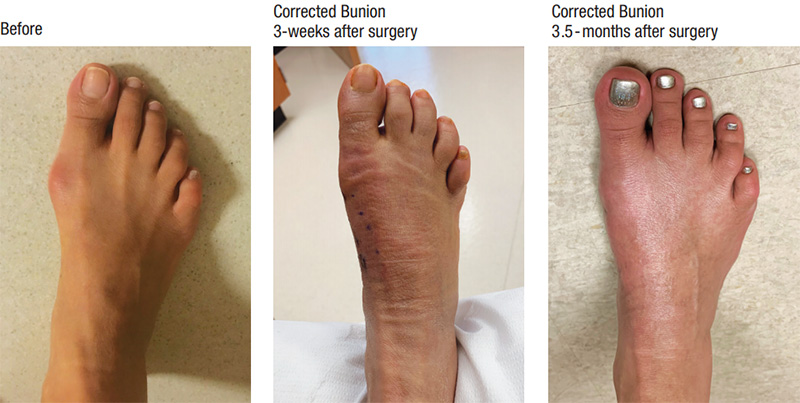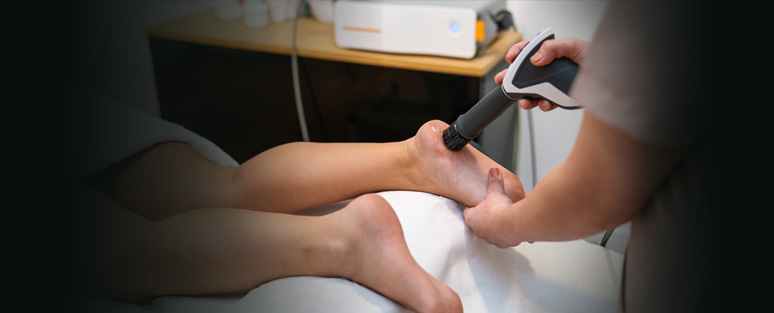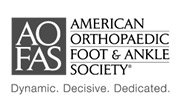Bunion Surgery
A bunion, also known as hallux valgus, is bony prominence at the base of the big toe, which often results in pain, redness and rubbing in footwear. The 1st metatarsal bone abnormally angles outward, creating that classic 'bump' medially. A bunion can change the shape of your foot, make it difficult for you to find shoes that fit correctly. More importantly, it can result in pain with activity that becomes limiting.
Causes
Although it is not clearly understood why bunions occur, possible causes include:
- Family history and genetics
- Arthritis (inflammation of the joints) including rheumatoid arthritis, psoriatic arthritis and gout
- Neuromuscular conditions such as cerebral palsy (affects movement and co-ordination)
- Connective tissue disorders such as Marfan’s syndrome (affects the connective tissues)
- Tight fitting shoes that are too tight, narrow or high heeled.
Signs and symptoms
The main indication of a bunion is the pointing of the big toe towards the other toes of the foot. Other signs and symptoms include:
- Pain and swelling over the big toe that increases while wearing shoes
- Swelling with red, sore and calloused skin at the base of the big toe
- Inward turning of the big toe pushes the second toe out of place
- Bony bump at the base of the big toe
- Sore skin over the bony bump
- Difficulty walking and wearing shoes
Diagnosis

The diagnosis of a bunion by an orthopaedic surgeon includes taking a medical history, and performing a physical examination to assess the extent of misalignment and damage to the soft tissues. Your surgeon will usually order weight bearing X-rays (i.e. taken while standing) to access the severity of the bunion and to assess the condition of the joints.
Treatment
Your PCP may have already initially recommended conservative treatment measures with the goal of reducing or eliminating your foot pain.
Such measures can include:
- Medications for relieving pain and inflammation
- Wearing surgical shoes with a wide and high toe box, avoiding tight, pointed or high-heeled shoes.
- Use of orthotics to realign the bones of your foot and ease pain.
- Padding of bunions
- Ice applications several times a day
Conservative treatment measures can help relieve the discomfort of a bunion, however these measures will not prevent the bunion from becoming worse.
Surgery
Surgery is the only means of truly correcting a bunion. Surgery is only recommended when conservative measures fail to treat the symptoms of bunion. Many patients manage their bunions without surgery by accommodating the widening forefoot. However, as the bunion worsens, there are mechanical changes that affect the functional of the foot and impair activity, particularly if the great toe is affecting the second toe, and this is what usually drives the need to correct the bunion.
There are many surgical options to treat a bunion. The common goal is to realign the bones in the foot, correct the deformity, and relieve pain and discomfort. The surgery is performed as a day procedure, under the effect of a light general anaesthetic and a regional nerve block. Depending on how the bunion is corrected, some weight-bearing can be allowed as directed by Dr. Mesnier. Bunions can be corrected by either an osteotomy or an arthrodesis.
An osteotomy is a common type of bunion surgery that involves the surgical cutting and realignment of the bones around your great toe joint. Your surgeon selects the appropriate surgical procedure based on the type of bunion and its severity. Traditionally, this was done through large incisions to accommodate the tools needed to do the osteotomy. More recently, Dr. Mesnier has been approaching bunions differently with a minimally invasive approach which dramatically diminishes swelling and stiffness after surgery.
An arthrodesis is a type of procedure that is usually performed when there is significant arthritis associated with a bunion. It involves realigning the great toe at the joint, and having the joint fuse together.
Motion is reduced, but pain and deformity are very well controlled.
There are 3 main types of osteotomies used by foot and ankle surgeons; namely
- Akin Osteotomy
- Distal Metatarsal Osteotomy
- Proximal Metatarsal Osteotomy
Akin Osteotomy
Akin osteotomy corrects the sideways deviation of the big toe. In this procedure, your surgeon makes a small cut in the proximal phalanx (base of the big toe) and removes a wedge of bone to straighten the big toe. The bony fragments are then stabilized using a screw or staples. This procedure is often used in conjunction with the other procedures below. Dr. Mesnier has specific training in performing this procedure through a minimally invasive approach, using keyhole style incisions.
Distal Metatarsal Osteotomy
A distal metatarsal osteotomy is usually recommended for mild to moderate bunion deformities, but can also be used for a severe deformity. Traditionally, during this procedure, your surgeon will make an incision over your big toe. The joint capsule is opened and the bunion is removed using a surgical saw. A V-shaped cut is made on your big toe and the metatarsal bones are shifted to bring your toe into its normal anatomical position. The bunion is then shaved and the soft tissues are realigned to correct the position. Akin osteotomy may be performed if necessary. The mobility of your big toe is examined, and the capsule and wound are re-approximated with sutures. Screws or pins are used to hold the bones in their new position until healing.
However, Dr. Mesnier has specific training in performing this procedure through a minimally invasive approach, using keyhole style incisions. This eliminates the large incisions which contribute to post-operative pain and swelling.
Proximal Metatarsal Osteotomy
A proximal metatarsal osteotomy is usually recommended for moderate to severe bunion deformities. Traditionally, the surgery would entail making an incision along your big toe and opening the joint capsule to expose the bump. The bump is then removed using a bone saw. The proximal first metatarsal bone is then cut and the bone is realigned to correct the deformity, and screws are used to hold the new alignment until the bone heals. The joint capsule and surgical wounds are then re-approximated using. This is a very powerful corrective procedure with excellent long term results.
Dr. Mesnier has specific training in performing this procedure through a minimally invasive approach, using keyhole style incisions, eliminating the large incisions which contribute to post-operative pain, swelling, and stiffness.
Risks and complications
As with any surgery, bunion surgery involves certain risks and complications. They include:
- Infection
- Recurrence of the bunion
- Nerve damage
- Unresolved pain and swelling
- Joint stiffness or restricted movement
- Osteonecrosis
- Delayed healing or healing in the wrong position
In rare cases, a second surgery may be necessary to correct the problems.
Post-operative care
Patients should follow all instructions given by Dr. Mesnier following the surgery. These include:
- Keep your dressings dry and leave them in place until your next outpatient appointment.
- Minimize walking where possible.
- Elevate the foot to minimize swelling as much as possible for the first 6 weeks.
- You will have to wear specially designed post-operative shoes to protect the wounds and assist in walking
- You may not be able to wear regular shoes for 6 to 8 weeks

You will need the Adobe Reader to view and print the above documents. 














